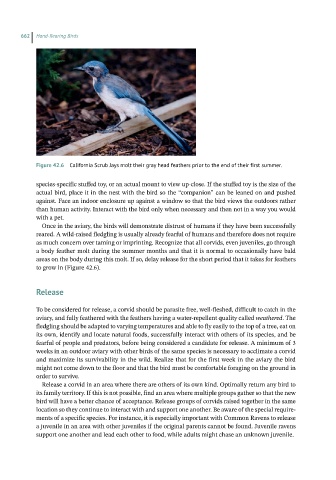Page 661 - Hand rearing birds second
P. 661
662 Hand-Rearing Birds
Figure 42.6 California Scrub Jays molt their gray head feathers prior to the end of their first summer.
species-specific stuffed toy, or an actual mount to view up-close. If the stuffed toy is the size of the
actual bird, place it in the nest with the bird so the “companion” can be leaned on and pushed
against. Face an indoor enclosure up against a window so that the bird views the outdoors rather
than human activity. Interact with the bird only when necessary and then not in a way you would
with a pet.
Once in the aviary, the birds will demonstrate distrust of humans if they have been successfully
reared. A wild-raised fledgling is usually already fearful of humans and therefore does not require
as much concern over taming or imprinting. Recognize that all corvids, even juveniles, go through
a body feather molt during the summer months and that it is normal to occasionally have bald
areas on the body during this molt. If so, delay release for the short period that it takes for feathers
to grow in (Figure 42.6).
Release
To be considered for release, a corvid should be parasite free, well-fleshed, difficult to catch in the
aviary, and fully feathered with the feathers having a water-repellent quality called weathered. The
fledgling should be adapted to varying temperatures and able to fly easily to the top of a tree, eat on
its own, identify and locate natural foods, successfully interact with others of its species, and be
fearful of people and predators, before being considered a candidate for release. A minimum of 3
weeks in an outdoor aviary with other birds of the same species is necessary to acclimate a corvid
and maximize its survivability in the wild. Realize that for the first week in the aviary the bird
might not come down to the floor and that the bird must be comfortable foraging on the ground in
order to survive.
Release a corvid in an area where there are others of its own kind. Optimally return any bird to
its family territory. If this is not possible, find an area where multiple groups gather so that the new
bird will have a better chance of acceptance. Release groups of corvids raised together in the same
location so they continue to interact with and support one another. Be aware of the special require-
ments of a specific species. For instance, it is especially important with Common Ravens to release
a juvenile in an area with other juveniles if the original parents cannot be found. Juvenile ravens
support one another and lead each other to food, while adults might chase an unknown juvenile.

